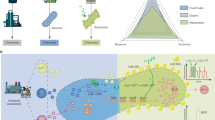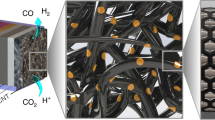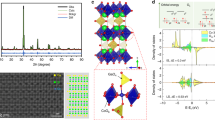Abstract
The clean conversion of carbon dioxide and water to a single multicarbon product and O2 using sunlight via photocatalysis without the assistance of organic additives or electricity remains an unresolved challenge. Here we report a bio-abiotic hybrid system with the non-photosynthetic, CO2-fixing acetogenic bacterium Sporomusa ovata grown on a scalable and cost-effective photocatalyst sheet consisting of a pair of particulate semiconductors (La and Rh co-doped SrTiO3 (SrTiO3:La,Rh) and Mo-doped BiVO4 (BiVO4:Mo)). The biohybrid effectively produces acetate (CH3COO–) and oxygen (O2) using only sunlight, CO2 and H2O, achieving a solar-to-acetate conversion efficiency of 0.7% at ambient conditions (298 K, 1 atm). The photocatalyst sheet oxidizes water to O2 and provides electrons and hydrogen (H2) to S. ovata for the selective synthesis of CH3COO– from CO2. To demonstrate utility in a closed carbon cycle, the solar-generated acetate was used directly as feedstock in a bioelectrochemical system for electricity generation. These semi-biological approaches thus offer a promising strategy for sustainably and cleanly fixing CO2 and closing the carbon cycle.

This is a preview of subscription content, access via your institution
Access options
Access Nature and 54 other Nature Portfolio journals
Get Nature+, our best-value online-access subscription
$29.99 / 30 days
cancel any time
Subscribe to this journal
Receive 12 digital issues and online access to articles
$119.00 per year
only $9.92 per issue
Buy this article
- Purchase on Springer Link
- Instant access to full article PDF
Prices may be subject to local taxes which are calculated during checkout





Similar content being viewed by others
Data availability
All source data that support the findings of this study are available from the University of Cambridge data repository: https://doi.org/10.17863/CAM.84871.
Change history
03 August 2022
A Correction to this paper has been published: https://doi.org/10.1038/s41929-022-00835-x
References
Jiang, K. et al. Metal ion cycling of Cu foil for selective C–C coupling in electrochemical CO2 reduction. Nat. Catal. 1, 111–119 (2018).
Morales-Guio, C. G. et al. Improved CO2 reduction activity towards C2+ alcohols on a tandem gold on copper electrocatalyst. Nat. Catal. 1, 764–771 (2018).
Nitopi, S. et al. Progress and perspectives of electrochemical CO2 reduction on copper in aqueous electrolyte. Chem. Rev. 119, 7610–7672 (2019).
García de Arquer, F. P. et al. CO2 electrolysis to multicarbon products at activities greater than 1 A cm−2. Science 367, 661–666 (2020).
Rahaman, M., Dutta, A., Zanetti, A. & Broekmann, P. Electrochemical reduction of CO2 into multicarbon alcohols on activated Cu mesh catalysts: an identical location (IL) study. ACS Catal. 7, 7946–7956 (2017).
Birdja, Y. Y. et al. Advances and challenges in understanding the electrocatalytic conversion of carbon dioxide to fuels. Nat. Energy 4, 732–745 (2019).
Claassens, N. J., Sousa, D. Z., dos Santos, V. A. P. M., de Vos, W. M. & van der Oost, J. Harnessing the power of microbial autotrophy. Nat. Rev. Microbiol. 14, 692–706 (2016).
Lapinsonnière, L., Picot, M. & Barrière, F. Enzymatic versus microbial bio-catalyzed electrodes in bio-electrochemical systems. ChemSusChem 5, 995–1005 (2012).
Cestellos-Blanco, S., Zhang, H., Kim, J. M., Shen, Y.-X. & Yang, P. Photosynthetic semiconductor biohybrids for solar-driven biocatalysis. Nat. Catal. 3, 245–255 (2020).
Kornienko, N., Zhang, J. Z., Sakimoto, K. K., Yang, P. & Reisner, E. Interfacing nature’s catalytic machinery with synthetic materials for semi-artificial photosynthesis. Nat. Nanotechnol. 13, 890–899 (2018).
Bian, B., Bajracharya, S., Xu, J., Pant, D. & Saikaly, P. E. Microbial electrosynthesis from CO2: challenges, opportunities and perspectives in the context of circular bioeconomy. Bioresour. Technol. 302, 122863 (2020).
Li, H. et al. Integrated electromicrobial conversion of CO2 to higher alcohols. Science 335, 1596–1596 (2012).
Haas, T., Krause, R., Weber, R., Demler, M. & Schmid, G. Technical photosynthesis involving CO2 electrolysis and fermentation. Nat. Catal. 1, 32–39 (2018).
Liu, C. et al. Nanowire–Bacteria hybrids for unassisted solar carbon dioxide fixation to value-added chemicals. Nano Lett. 15, 3634–3639 (2015).
Nichols, E. M. et al. Hybrid bioinorganic approach to solar-to-chemical conversion. Proc. Natl Acad. Sci. USA 112, 11461–11466 (2015).
Liu, C., Colón, B. C., Ziesack, M., Silver, P. A. & Nocera, D. G. Water splitting–biosynthetic system with CO2 reduction efficiencies exceeding photosynthesis. Science 352, 1210–1213 (2016).
Sakimoto, K. K., Zhang, S. J. & Yang, P. Cysteine–cystine photoregeneration for oxygenic photosynthesis of acetic acid from CO2 by a tandem inorganic–biological hybrid system. Nano Lett. 16, 5883–5887 (2016).
Su, Y. et al. Close-packed nanowire-bacteria hybrids for efficient solar-driven CO2 fixation. Joule 4, 800–811 (2020).
Wang, Q. et al. Scalable water splitting on particulate photocatalyst sheets with a solar-to-hydrogen energy conversion efficiency exceeding 1%. Nat. Mater. 15, 611–615 (2016).
Geisz, J. F. et al. Six-junction III–V solar cells with 47.1% conversion efficiency under 143 Suns concentration. Nat. Energy 5, 326–335 (2020).
Yoshikawa, K. et al. Silicon heterojunction solar cell with interdigitated back contacts for a photoconversion efficiency over 26%. Nat. Energy 2, 17032 (2017).
Ager, J. W., Shaner, M. R., Walczak, K. A., Sharp, I. D. & Ardo, S. Experimental demonstrations of spontaneous, solar-driven photoelectrochemical water splitting. Energy Environ. Sci. 8, 2811–2824 (2015).
Fabian, D. M. et al. Particle suspension reactors and materials for solar-driven water splitting. Energy Environ. Sci. 8, 2825–2850 (2015).
Pinaud, B. A. et al. Technical and economic feasibility of centralized facilities for solar hydrogen production via photocatalysis and photoelectrochemistry. Energy Environ. Sci. 6, 1983–2002 (2013).
Gai, P. et al. Solar-powered organic semiconductor–bacteria biohybrids for CO2 reduction into acetic acid. Angew. Chem. Int. Ed. Engl. 59, 7224–7229 (2020).
Sakimoto, K. K., Wong, A. B. & Yang, P. Self-photosensitization of nonphotosynthetic bacteria for solar-to-chemical production. Science 351, 74–77 (2016).
Zhang, H. et al. Bacteria photosensitized by intracellular gold nanoclusters for solar fuel production. Nat. Nanotechnol. 13, 900–905 (2018).
Göbbels, L. et al. Cysteine: an overlooked energy and carbon source. Sci. Rep. 11, 2139 (2021).
Kaden, J., S. Galushko, A. & Schink, B. Cysteine-mediated electron transfer in syntrophic acetate oxidation by cocultures of Geobacter sulfurreducens and Wolinella succinogenes. Arch. Microbiol. 178, 53–58 (2002).
Liu, D., Dong, H., Zhao, L. & Wang, H. Smectite reduction by Shewanella species as facilitated by cystine and cysteine. Geomicrobiol. J. 31, 53–63 (2014).
Zhu, S. & Wang, D. Photocatalysis: basic principles, diverse forms of implementations and emerging scientific opportunities. Adv. Energy Mater. 7, 1700841 (2017).
Wang, Q. et al. Molecularly engineered photocatalyst sheet for scalable solar formate production from carbon dioxide and water. Nat. Energy 5, 703–710 (2020).
Wang, Q. et al. Z-scheme water splitting using particulate semiconductors immobilized onto metal layers for efficient electron relay. J. Catal. 328, 308–315 (2015).
Li, X., Yu, J., Jaroniec, M. & Chen, X. Cocatalysts for selective photoreduction of CO2 into solar fuels. Chem. Rev. 119, 3962–4179 (2019).
Nevin, K. P., Woodard, T. L., Franks, A. E., Summers, Z. M. & Lovley, D. R. Microbial electrosynthesis: feeding microbes electricity to convert carbon dioxide and water to multicarbon extracellular organic compounds. mBio 1, e00103–e00110 (2010).
Moss, B. et al. Linking in situ charge accumulation to electronic structure in doped SrTiO3 reveals design principles for hydrogen-evolving photocatalysts. Nat. Mater. 20, 511–517 (2021).
Wang, Q. et al. Printable photocatalyst sheets incorporating a transparent conductive mediator for Z-scheme water splitting. Joule 2, 2667–2680 (2018).
Ebihara, M. et al. Charge carrier mapping for Z-scheme photocatalytic water-splitting sheet via categorization of microscopic time-resolved image sequences. Nat. Commun. 12, 3716 (2021).
Maeda, K. et al. Noble-Metal/Cr2O3 core/shell nanoparticles as a cocatalyst for photocatalytic overall water splitting. Angew. Chem. Int. Ed. Engl. 45, 7806–7809 (2006).
Fang, X., Kalathil, S., Divitini, G., Wang, Q. & Reisner, E. A three-dimensional hybrid electrode with electroactive microbes for efficient electrogenesis and chemical synthesis. Proc. Natl Acad. Sci. USA 117, 5074–5080 (2020).
Cerdan, S., Künnecke, B. & Seelig, J. Cerebral metabolism of [1,2-13C2]acetate as detected by in vivo and in vitro 13C NMR. J. Biol. Chem. 265, 12916–12926 (1990).
Wasylenko, T. M. & Stephanopoulos, G. Kinetic isotope effects significantly influence intracellular metabolite 13C labeling patterns and flux determination. Biotechnol. J. 8, 1080–1089 (2013).
Millard, P., Portais, J.-C. & Mendes, P. Impact of kinetic isotope effects in isotopic studies of metabolic systems. BMC Syst. Biol. 9, 64 (2015).
Morello, G., Megarity, C. F. & Armstrong, F. A. The power of electrified nanoconfinement for energising, controlling and observing long enzyme cascades. Nat. Commun. 12, 340 (2021).
Kudo, A., Omori, K. & Kato, H. A novel aqueous process for preparation of crystal form-controlled and highly crystalline BiVO4 powder from layered vanadates at room temperature and its photocatalytic and photophysical properties. J. Am. Chem. Soc. 121, 11459–11467 (1999).
Lyu, H. et al. An Al-doped SrTiO3 photocatalyst maintaining sunlight-driven overall water splitting activity for over 1000 h of constant illumination. Chem. Sci. 10, 3196–3201 (2019).
Lu, Z. & Imlay, J. A. When anaerobes encounter oxygen: mechanisms of oxygen toxicity, tolerance and defence. Nat. Rev. Microbiol. 19, 774–785 (2021).
Jenney, F. E., Verhagen, M. F. J. M., Cui, X. & Adams, M. W. W. Anaerobic microbes: oxygen detoxification without superoxide dismutase. Science 286, 306–309 (1999).
Nakanishi, T., Inoue, H. & Kitamura, M. Cloning and expression of the superoxide dismutase gene from the obligate anaerobic bacterium Desulfovibrio vulgaris (Miyazaki F). J. Biochem. 133, 387–393 (2003).
Lumppio, H. L., Shenvi, N. V., Summers, A. O., Voordouw, G. & Kurtz, D. M. Rubrerythrin and rubredoxin oxidoreductase in Desulfovibrio vulgaris: a novel oxidative stress protection system. J. Bacteriol. 183, 101–108 (2001).
Ward, D. E. et al. The NADH oxidase from Pyrococcus furiosus. Eur. J. Biochem. 268, 5816–5823 (2001).
Lin, W. C., Coppi, M. V. & Lovley, D. R. Geobacter sulfurreducens can grow with oxygen as a terminal electron acceptor. Appl. Environ. Microbiol. 70, 2525–2528 (2004).
Abdollahi, H. & Wimpenny, J. W. T. Effects of oxygen on the growth of Desulfovibrio desulfuricans. Microbiology 136, 1025–1030 (1990).
Boga, H. I. & Brune, A. Hydrogen-dependent oxygen reduction by homoacetogenic bacteria isolated from termite guts. Appl. Environ. Microbiol. 69, 779–786 (2003).
Poehlein, A., Gottschalk, G. & Daniel, R. First insights into the genome of the Gram-negative, endospore-forming organism Sporomusa ovata strain H1 DSM 2662. Genome Announc. 1, e00734-13 (2013).
Last, G. V. & Schmick, M. T. A review of major non-power-related carbon dioxide stream compositions. Environ. Earth Sci. 74, 1189–1198 (2015).
Agreda, V. H. Acetic Acid and Its Derivatives (CRC Press, 1993).
Bond, D. R. & Lovley, D. R. Electricity production by Geobacter sulfurreducens attached to electrodes. Appl. Environ. Microbiol. 69, 1548–1555 (2003).
Logan, B. E., Rossi, R., Ragab, A. A. & Saikaly, P. E. Electroactive microorganisms in bioelectrochemical systems. Nat. Rev. Microbiol. 17, 307–319 (2019).
Clomburg, J. M., Crumbley, A. M. & Gonzalez, R. Industrial biomanufacturing: the future of chemical production. Science 355, aag0804 (2017).
Nishiyama, H. et al. Photocatalytic solar hydrogen production from water on a 100 m2-scale. Nature 598, 304–307 (2021).
Bradford, M. M. A rapid and sensitive method for the quantitation of microgram quantities of protein utilizing the principle of protein-dye binding. Anal. Biochem. 72, 248–254 (1976).
Acknowledgements
We thank M. Rahaman, L. Su and M. Miller (University of Cambridge) for helpful discussions, and H. Greer at the University of Cambridge for assisting in the collection of SEM–EDX element-mapping images. This work was supported by the European Research Council Consolidator Grant ‘MatEnSAP’ (no. 682833 to E.R.), the UK Research and Innovation Cambridge Creative Circular Plastics Centre (grant no. EP/S025308), European Marie Sklodowska-Curie individual Fellowships (nos. GAN 793996 to Q.W. and GAN 744317 to S.K.), Research England’s Expanding Excellence in England (E3) Fund (to S.K.), the Cambridge Trust (Cambridge Thai Foundation Award to C.P.) and a Trinity-Henry Barlow Scholarship (to C.P.).
Author information
Authors and Affiliations
Contributions
Q.W., S.K. and E.R. conceived the idea and designed the project. Q.W. prepared the photocatalyst sheet and photoelectrodes and conducted physical characterization of semiconductors. S.K. and Q.W. carried out bacterial culture. S.K. quantified proteins and performed microbial electrogenesis. C.P. recorded SEM and SEM–EDX element-mapping images. Q.W. and C.P. carried out H2 and O2 quantification. S.K., C.D.S. and C.P. quantified acetate. The O2 tolerance ability of bacteria was investigated by C.D.S. and S.K. C.D.S., S.K. and Q.W. conducted isotopic labelling experiments. All authors analysed the data and discussed the results. Q.W., S.K. and E.R. wrote the manuscript with assistance from the co-authors. E.R. supervised the project.
Corresponding author
Ethics declarations
Competing interests
The authors declare no competing interests.
Peer review
Peer review information
Nature Catalysis thanks the anonymous reviewers for their contribution to the peer review of this work.
Additional information
Publisher’s note Springer Nature remains neutral with regard to jurisdictional claims in published maps and institutional affiliations.
Supplementary information
Supplementary Information
Supplementary Figs. 1–18 and Tables 1–5.
Rights and permissions
Springer Nature or its licensor holds exclusive rights to this article under a publishing agreement with the author(s) or other rightsholder(s); author self-archiving of the accepted manuscript version of this article is solely governed by the terms of such publishing agreement and applicable law.
About this article
Cite this article
Wang, Q., Kalathil, S., Pornrungroj, C. et al. Bacteria–photocatalyst sheet for sustainable carbon dioxide utilization. Nat Catal 5, 633–641 (2022). https://doi.org/10.1038/s41929-022-00817-z
Received:
Accepted:
Published:
Issue Date:
DOI: https://doi.org/10.1038/s41929-022-00817-z
This article is cited by
-
CO2 fixation into carbon nanofibres using electrochemical–thermochemical tandem catalysis
Nature Catalysis (2024)
-
Characterization and environmental applications of soil biofilms: a review
Environmental Chemistry Letters (2024)
-
Photocatalytic CO2 reduction
Nature Reviews Methods Primers (2023)
-
Advances and challenges in developing cocatalysts for photocatalytic conversion of carbon dioxide to fuels
Nano Research (2022)



